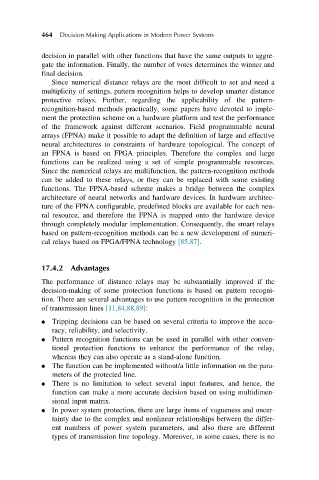Page 504 - Decision Making Applications in Modern Power Systems
P. 504
464 Decision Making Applications in Modern Power Systems
decision in parallel with other functions that have the same outputs to aggre-
gate the information. Finally, the number of votes determines the winner and
final decision.
Since numerical distance relays are the most difficult to set and need a
multiplicity of settings, pattern recognition helps to develop smarter distance
protective relays. Further, regarding the applicability of the pattern-
recognition-based methods practically, some papers have devoted to imple-
ment the protection scheme on a hardware platform and test the performance
of the framework against different scenarios. Field programmable neural
arrays (FPNA) make it possible to adapt the definition of large and effective
neural architectures to constraints of hardware topological. The concept of
an FPNA is based on FPGA principles. Therefore the complex and large
functions can be realized using a set of simple programmable resources.
Since the numerical relays are multifunction, the pattern-recognition methods
can be added to these relays, or they can be replaced with some existing
functions. The FPNA-based scheme makes a bridge between the complex
architecture of neural networks and hardware devices. In hardware architec-
ture of the FPNA configurable, predefined blocks are available for each neu-
ral resource, and therefore the FPNA is mapped onto the hardware device
through completely modular implementation. Consequently, the smart relays
based on pattern-recognition methods can be a new development of numeri-
cal relays based on FPGA/FPNA technology [85,87].
17.4.2 Advantages
The performance of distance relays may be substantially improved if the
decision-making of some protection functions is based on pattern recogni-
tion. There are several advantages to use pattern recognition in the protection
of transmission lines [11,84,88,89]:
Tripping decisions can be based on several criteria to improve the accu-
racy, reliability, and selectivity.
Pattern recognition functions can be used in parallel with other conven-
tional protection functions to enhance the performance of the relay,
whereas they can also operate as a stand-alone function.
The function can be implemented without/a little information on the para-
meters of the protected line.
There is no limitation to select several input features, and hence, the
function can make a more accurate decision based on using multidimen-
sional input matrix.
In power system protection, there are large items of vagueness and uncer-
tainty due to the complex and nonlinear relationships between the differ-
ent numbers of power system parameters, and also there are different
types of transmission line topology. Moreover, in some cases, there is no

